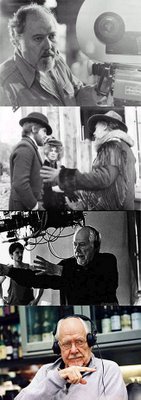
It looks like there will be a new Jess Franco title appearing in 2007, but there won't be any more new Robert Altman films...
The first day of 2007 is an appropriate time for me to comment on the loss of a major innovator in American cinema from the 1970s onward. When I first heard of the death of Robert Altman last November at the age of 81 I remembered Monica Swinn's comment in OBSESSION: THE FILMS OF JESS FRANCO that "Jess...liked Robert Altman a lot... ." She worked with Franco in the mid 1970s when he was furiously turning out some of his lowest budgeted and most personal works at a rate of sometimes 12 a year! My favorite Altman films also come from that period. They would include MC CABE & MRS MILLER (1971), IMAGES (1972), THE LONG GOODBYE (1973) and NASHVILLE (1975), among others. All boldly broke conventional genre barriers. MC CABE is a symphony of dreamy, elaborate zooms and soft-focus interludes which create a spectral quality startling in a film purporting to be a western. There's also an on-the edge-elegance to the intricate zooms (although many will insist that they just attest to lazy filmmaking) in many of Franco's Robert de Nesle produced films of that era along with the ultimate zoom/rack focus fest, LA COMTESSE NOIRE.
Both rather obscure films which should be sought out, it's especially interesting to compare Altman's IMAGES to Franco's AL OTRO LADO DEL ESPEJO, both were filmed on islands in the Atlantic (Ireland; Madiera) and are told from the point of view of a woman who is undergoing a violent mental breakdown. They shatter the comfortable illusion that what we see (in cinema and in life) is the whole truth rather than an impression, suggesting that ontological (and cinema) reality is a question rather than an answer before finally obliterating that consciousness by the very optical devices (lenses, mirrors, cameras) through which we establish our self-image. In the much criticized (at the time) THE LONG GOODBYE, with its inversion of decades of established Film Noir motifs, there could be a possible model for Franco's long running Al Periera series of neo noirs.
Altman's methods were notably similar to Franco's at that time: reducing adherence to completed scripts and shooting with more attention to on-set actor's improvisations, including chance environmental elements (the extraordinary snowstorm which blows in during the climax of MC CABE) which couldn't be prescripted, a focus on ensemble blocking rather than single protagonists, an impressionistic sound design where overlapping dialogues, music, sound were tonal and of equal value along with an always musical, nonlinear overall structure. Franco often calls himself a musician who makes films and so was Altman at his best. Altman's very last film is a musical-comedy which has some a number of interesting similarites to Franco's long standing fascination with musicians-in-peril scenarios from VAMPS OF 1930 to VENUS IN FURS.
Especially in the early to mid 1970s both used the telezoom as an aesthetic device to artfully collapse and expand space scan from wide to close perspective and back creating a stylistic fluidity, finding compelling spatial relationships in seemingly banal areas and familiar zones .The camera was always roving and exploring in Altman's best work as it does in the long plan sequences of Franco's GEMIDOS DE PLACER. One gets the feeling that both filmmakers had an intense fascination with the interactive relationship between inatimate objects and human figures, external environments and interior states, music and film, the art of the movie deal and the mysteries of chance. The difference is that Jess Franco remained a B, C, an Z series auteur while Altman utlimately converted cult status into a degree of acceptance from the Hollywood system he so consistently satirized and challenged.
(c) Robert Monell 2007

3 comments:
I think one of the best uses of zoom for Franco would have to be A VIRGIN AMONG THE LIVING DEAD. The constant zooming in towards the titular character gives us a feeling of connecting with her and the unnatural situation into which she has been thrust.
My favorite Altman film remains THAT COLD DAY IN THE PARK, a precusor to the more splintered IMAGES and 3 WOMEN. I always think of Jess Franco when I watch the film. The cumulative effect of all the zooming and panning into reflective surfaces, overlapping dialogue, and near-constant rainfall, is like slowly drowning in a whirlpool. It's a morbid, claustraphobic piece comparable to AL OTRO LADO DEL ESPEJO.
I once saw an old advertisement for a triple feature of 99 WOMEN, THAT COLD DAY IN THE PARK, and another title that escapes me at the moment. That would have been one heck of a show.
Oops, I forgot to sign that last comment.
-Adam Williams
Post a Comment